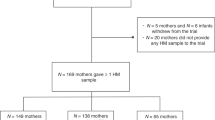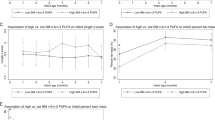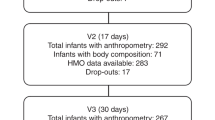Abstract
Background/Objectives:
Breastfeeding may protect against excessive weight gain during infancy. However, the breast milk components responsible for this effect are unknown. We examined the variation of three breast milk hormones (adiponectin, leptin and insulin) according to maternal characteristics and determined their association with infant body composition.
Subjects/Methods:
We studied a representative subset of 430 breastfed infants in the CHILD birth cohort. Breast milk was collected at 4 months postpartum and hormone concentrations were measured using the MesoScale Discovery System. Weight-for-length (WFL) and body mass index (BMI) z-scores were calculated according to the World Health Organization reference standard from infant anthropometrics measured at 4 months and 1 year. Maternal BMI and demographics were self-reported.
Results:
Breast milk hormone concentrations varied widely between mothers. The geometric mean (range) was 19.4 (3.7–74.4) ngml−1 for adiponectin; 361 (31–3968) pgml−1 for leptin; and 589 (53–5557) pgml−1 for insulin. Maternal BMI was positively correlated with breast milk insulin (r=+0.40, P<0.0001) and leptin (r=+0.71, P<0.0001), but not adiponectin (r=−0.02, P=0.68). Breast milk hormone concentrations were also associated with maternal ethnicity, parity and breastfeeding exclusivity at sample collection. Independent of these factors and maternal diabetes, smoking and breastfeeding duration, higher breast milk leptin was associated with lower infant WFL z-score at 4 months (β −0.67, 95% confidence interval (CI): −1.17, −0.17 for highest vs lowest quintile) and 1 year (β −0.58, 95% CI: −1.02, −0.14). Insulin showed a U-shaped association, with intermediate concentrations predicting the lowest infant WFL z-score at 4 months (β −0.51, 95% CI: −0.87, −0.15 for third vs lowest quintile) and 1 year (β −0.35, 95% CI: −0.66, −0.04). Similar results were seen with infant BMI. Breast milk adiponectin was not significantly associated with infant body composition.
Conclusions:
Breast milk hormone concentrations were associated with several fixed and modifiable maternal characteristics. Higher concentrations of leptin and intermediate concentrations of insulin were associated with lower infant WFL in the first year of life.
This is a preview of subscription content, access via your institution
Access options
Subscribe to this journal
Receive 12 print issues and online access
$259.00 per year
only $21.58 per issue
Buy this article
- Purchase on Springer Link
- Instant access to full article PDF
Prices may be subject to local taxes which are calculated during checkout


Similar content being viewed by others
References
James WPT . The challenge of childhood obesity. Int J Pediatr Obes 2006; 1: 7–10.
World Health Organization. Obesity: Preventing and Managing the Global Epidemic. WHO Technical Report Series 894. WHO: Geneva, 2000.
World Health Organization. Report of the Commission on Ending Childhood Obesity. WHO: Geneva, 2016.
World Health Organization.Obesity and Overweight. WHO: Geneva, 2014.
Barker D . The fetal and infant origins of adult disease. Br Med J 1990; 301: 1111.
Symonds ME, Sebert SP, Hyatt MA, Budge H . Nutritional programming of the metabolic syndrome. Nat Rev Endocrinol 2009; 5: 604–610.
Smego A, Woo JG, Klein J, Suh C, Bansal D, Bliss S et al. High body mass index in infancy may predict severe obesity in early childhood. J Pediatr 2017; 183: 87–93.
Horta BL, Victora CG . Long-Term Health Effects of Breastfeeding. World Health Organization: Geneva, 2013; pp 57–64.
Owen C, Martin R, Whincup P, Davey-Smith G, Gillman M, Cook D . The effect of breastfeeding on mean body mass index throughout life: a quantative review of published and unpublished obsevational evidence. Am J Clin Nutr 2005; 82: 1298–1307.
Arenz S, Rückerl R, Koletzko B, von Kries R . Breast-feeding and childhood obesity—a systematic review. Int J Obes 2004; 28: 1247–1256.
Bartok CJ, Ventura AK . Mechanisms underlying the association between breastfeeding and obesity. Int J Pediatr Obes 2009; 4: 196–204.
Young BE, Johnson SL, Krebs NF . Biological determinants linking infant weight gain and child obesity: current knowledge and future directions. Adv Nutr 2012; 3: 675–686.
Savino F, Benetti S, Liguori SA, Sorrenti M, Cordero Di Montezemolo L . Advances on human milk hormones and protection against obesity. Cell Mol Biol 2013; 59: 89–98.
Fields DA, Schneider CR, Pavela G . A narrative review of the associations between six bioactive components in breast milk and infant adiposity. Obesity 2016; 24: 1213–1221.
Weyermann M, Brenner H, Rothenbacher D . Adipokines in human milk and risk of overweight in early childhood: a Prospective Cohort Study. Epidemiology 2007; 18: 722–729.
Savino F, Petrucci E, Nanni GE . Adiponectin: an intriguing hormone for paediatricians. Acta Paediatr 2008; 97: 701–705.
Catli G, Dundar N, Dundar B . Adipokines in breast milk: an update. J Clin Res Pediatr Endocrinol 2014; 6: 192–201.
Friedman JM . Leptin at 14 y of age: an ongoing story. Am J Clin Nutr 2009; 89 (suppl): 973–979.
Yoneda K, Tomimoto A, Endo H, Iida H, Sugiyama M, Takahashi H et al. Expression of adiponectin receptors, AdipoR1 and AdipoR2, in normal colon epithelium and colon cancer tissue. Oncol Rep 2008; 20: 479–483.
Barrenetxe J, Villaro AC, Guembe L, Pascual I, Muñoz-Navas M, Barber A et al. Distribution of the long leptin receptor isoform in brush border, basolateral membrane, and cytoplasm of enterocytes. Gut 2002; 50: 797–802.
Menard D, Corriveau B . Insulin modulates cellular proliferation in developing human jejunum and colon. Biol Neonate 1999; 75: 143–151.
Andreas NJ, Hyde MJ, Gale C, Parkinson JRC, Jeffries S, Holmes E et al. Effect of maternal body mass index on hormones in breast milk: a systematic review. PLoS ONE 2014; 9: 1–25.
Subbarao P, Anand SS, Becker AB, Befus AD, Brauer M, Brook JR et al. The Canadian Healthy Infant Longitudinal Development (CHILD) Study: examining developmental origins of allergy and asthma. Thorax 2015; 70: 998–1000.
Woo JG, Lourdes Guerrero M, Guo F, Martin LJ, Davidson BS, Ortega H et al. Human milk adiponectin impacts infant weight trajectory during the second year of life. J Pediatr Gastroenterol Nutr 2012; 54: 532–539.
Fields DA, Demerath EW . Relationship of insulin, glucose, leptin, IL-6 and TNF-alpha in human breast milk with infant growth and body composition. Pediatr Obes 2012; 7: 304–312.
Moraes TJ, Lefebvre DL, Chooniedass R, Becker AB, Brook JR, Denburg J et al. The Canadian Healthy Infant Longitudinal Development Birth Cohort Study: biological samples and biobanking. Paediatr Perinat Epidemiol 2015; 29: 84–92.
Ewaschuk JB, Unger S, Connor DLO, Stone D, Harvey S, Clandinin MT et al. Effect of pasteurization on selected immune components of donated human breast milk. J Perinatol 2011; 31: 593–598.
WHO. Child growth standards based on length/height, weight, and age. Acta Paediatr Suppl 2006; 450: 76–85.
WHO Multicenter Growth Reference Study. WHO Child Growth Standards: Length/Height-For-Age, Weight-For-Age, Weight-For-Length, Weight-For-Height and Body Mass Index-For-Age: Methods and Development. World Health Organization: Geneva, Switzerland: 2006.
Rolland-Cachera MF . Childhood obesity: current definitions and recommendations. Int J Pediatr Obes 2011; 33: 325–331.
Rifas-Shiman SL, Gillman MW, Oken E, Kleinman K, Taveras EM . Similarity of the CDC and WHO weight-for- length growth charts in predicting risk of obesity at age 5 years. Obesity 2012; 20: 1261–1265.
Roy SM, Spivack JG, Faith MS, Chesi A, Mitchell JA, Struan G et al. Infant BMI or weight-for-length and obesity risk in early childhood. Pediatrics 2016; 137: 1–9.
Azad M, Sharma A, de Souza R, Dolinsky VW, Becker AB, Mandhane PJ et al. Association between artificially sweetened beverage consumption during pregnancy and infant body mass index. JAMA Pediatr 2016; 170: 662–670.
American Congress of Obstetricians and Gynecologists. Weight gain during pregnancy. Committee Opinion No. 548. Obstet Gynecol 2013; 5: 210–212.
Schuster S, Hechler C, Gebauer C, Kiess W, Kratzsch J . Leptin in maternal serum and breast milk: association with infants’ body weight gain in a longitudinal study over 6 months of lactation. Pediatr Res 2011; 70: 633–637.
Doneray H, Orbak Z, Yildiz L . The relationship between breast milk leptin and neonatal weight gain. Acta Paediatr 2009; 98: 643–647.
Miralles O, Sanchez J, Palou A, Pico C . A physiological role of breast milk leptin in body weight control in developing infants. Obesity 2006; 14: 1371–1377.
Brunner S, Schmid D, Zang K, Much D, Knoeferl B, Kratzsch J et al. Breast milk leptin and adiponectin in relation to infant body composition up to 2 years. Pediatr Obes 2014; 10: 67–73.
Uçar B, Kirel B, Bör O, Kiliç F, Doğruel N, Aydoğdu S et al. Breast milk leptin concentrations in initial and terminal milk samples: relationships to maternal and infant plasma leptin concentrations, adiposity, serum glucose, insulin, lipid and lipoprotein levels. J Pediatr Endocrinol Metab 2000; 13: 149–159.
Uysal FK, Onal EE, Aral YZ, Adam B, Dilmen U, Ardiçolu Y . Breast milk leptin: its relationship to maternal and infant adiposity. Clin Nutr 2002; 21: 157–160.
Meyer DM, Brei C, Stecher L, Much D, Brunner S, Hauner H . The relationship between breast milk leptin and adiponectin with child body composition from 3 to 5 years: a follow-up study. Pediatr Obes 2016; 2–6.
Woo JG, Guerrero ML, Altaye M, Ruiz-Palacios GM, Martin LJ, Dubert-Ferrandon A et al. Human milk adiponectin is associated with infant growth in two independent cohorts. Breastfeed Med 2009; 4: 101–109.
Fields DA, George B, Williams M, Whitaker K, Allison DB, Teague A et al. Associations between human breast milk hormones and adipocytokines and infant growth and body composition in the first 6 months of life. Pediatr Obes 2017; pp 1–8.
Sánchez J, Priego T, Palou M, Tobaruela A, Palou A, Picó C . Oral supplementation with physiological doses of leptin during lactation in rats improves insulin sensitivity and affects food preferences later in life. Endocrinology 2008; 149: 733–740.
Buts J, De Keyser N, Sokal E, Marandi S . Oral insulin is biologically active on rat immature enterocytes. J Pediatr Gastroenterol Nutr 1997; 25: 230–232.
Kinouchi T, Koizumi K, Kuwata T, Yajima Y . Milk-borne insulin with trypsin inhibitor in milk induces pancreatic amylase development at the onset of weaning in rats. J Pediatr Gastroenterol Nutr 2000; 30: 515–521.
Shehadeh N, Wies R, Fishach O, Berant M, Etzioni A, Shamir R . Influence of oral insulin supplementation on carbohydrate, lipid and protein metabolism, in weaned Balb/c mice. J Pediatr Endocrinol Metab 2003; 16: 431–437.
Lemas DJ, Young BE, Ii PRB, Tomczik AC, Soderborg TK, Hernandez TL et al. Alterations in human milk leptin and insulin are associated with early changes in the infant intestinal microbiome. Am J Clin Nutr 2016; 103: 1291–1300.
Azad M, Konya T, Persaud R, Guttman D, Chari R, Field C et al. Impact of maternal intrapartum antibiotics, method of birth and breastfeeding on gut microbiota during the first year of life: a prospective cohort study. BJOG An Int J Obstet Gynaecol 2016; 123: 983–993.
Arrieta M-C, Stiemsma LT, Dimitriu PA, Thorson L, Russell S, Yurist-Doutsch S et al. Early infancy microbial and metabolic alterations affect risk of childhood asthma. Sci Transl Med 2015; 7: 1–14.
Young BE, Patinkin Z, Palmer C, Houssaye De B, Barbour LA, Hernandez T et al. Human milk insulin is related to maternal plasma insulin and BMI: but other components of human milk do not differ by BMI. Eur J Clin Nutr 2017; 1–7.
Ley SH, Hanley AJ, Sermer M, Zinman B, O’Connor DL . Associations of prenatal metabolic abnormalities with insulin and adiponectin concentrations in human milk. Am J Clin Nutr 2012; 95: 867–874.
Hatsu IE, Mcdougald DM, Anderson AK . Effect of infant feeding on maternal body composition. Int Breastfeed J 2008; 3: 1–8.
Acknowledgements
We are grateful to all the families who took part in this study, and the whole CHILD team, which includes interviewers, nurses, computer and laboratory technicians, clerical workers, research scientists, volunteers, managers and receptionists. We also thank Drs Atul Sharma and Arthur Owora for their statistical expertise. This research was funded by the Manitoba Medical Service Foundation and the Children’s Hospital Research Institute of Manitoba and supported by the Canadian Institutes of Health Research and the Allergy, Genes and Environment Networks of Centres of Excellence of Canada.
Author information
Authors and Affiliations
Consortia
Corresponding author
Ethics declarations
Competing interests
The authors declare no conflict of interest.
Additional information
Supplementary Information accompanies this paper on International Journal of Obesity website
Supplementary information
Rights and permissions
About this article
Cite this article
Chan, D., Goruk, S., Becker, A. et al. Adiponectin, leptin and insulin in breast milk: associations with maternal characteristics and infant body composition in the first year of life. Int J Obes 42, 36–43 (2018). https://doi.org/10.1038/ijo.2017.189
Received:
Revised:
Accepted:
Published:
Issue Date:
DOI: https://doi.org/10.1038/ijo.2017.189
This article is cited by
-
Multimodal machine learning for modeling infant head circumference, mothers’ milk composition, and their shared environment
Scientific Reports (2024)
-
Hormonal regulation of mammary gland development and lactation
Nature Reviews Endocrinology (2023)
-
Messaging and methodological considerations when researching breastfeeding and obesity
European Journal of Clinical Nutrition (2021)
-
Effects of perinatal factors on sirtuin 3, 8-hydroxy-2′- deoxyguanosine, brain-derived neurotrophic factor and serotonin in cord blood and early breast milk: an observational study
International Breastfeeding Journal (2020)
-
Hormone levels in preterm and donor human milk before and after Holder pasteurization
Pediatric Research (2020)



